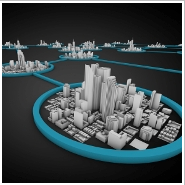Big data, technology, and the management of urban space
How Will Smart Cities Transform the Future? – post about Cisco Systems Smart+Connected Communities initiative. It combines data, technology, city services, and infrastructure into a network they say offers unprecedented opportunities (a “potential value of $14.4 trillion over the next decade“) for economic, social, and environmental sustainability.
This is happening today in the French city of Nice, where the Connected Boulevard uses technology to manage traffic, parking, waste, and pollution. In neighboring Spain, Barcelona has an even broader set of applications, including energy efficient and “aware” city blocks and public buildings, as well as rain water management and street lighting as a service.
These, plus Songdo International City and others, are Cisco’s “Iconic Cities” projects. The first in the U.S. will be Lake Nona near Orlando, Florida.
The June 2013 article cited above on Nice’s Connected Boulevard gives a glimpse into how it works since it’s the first of its kind.
…the Nice Côte d’Azur metropolitan authorities and the Nice city council have just launched, in partnership with IT network specialists Cisco Systems, the first-ever ‘connected’ urban avenue designed to combine two concepts: the Internet of Things and the management of urban space. The purpose of the initiative is to optimise the area’s environmental and energy management, at the same time providing the city with new drivers for economic growth. …
“The major challenge for this system is to progress from mere data transfer to real information transfer,” … In fact these sensors produce a huge amount of data; not all of it will be automatically sent to the computer centre. The challenge is to create a network that is capable of flagging information which has high operational value – a sudden major change in temperature, for instance…
Here’s a statistic to ponder, from the same article: “…there will be around 30 billion wireless connected objects in the world in 2020…” Wow. So how does all that wireless connectivity swirling around us effect the human body’s electrical system?

